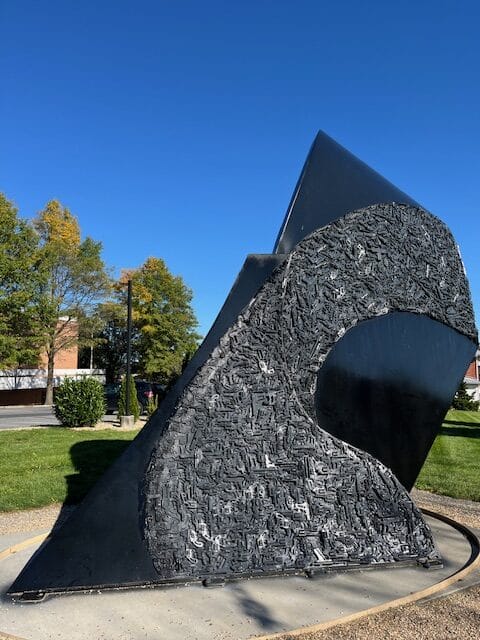
By Mary Ann Zehr, contributor
When my Mennonite parents came to visit me in my home in D.C. in the late 1990s, they didn’t ask me to take them to the White House or the U.S. Capitol or other sites frequently visited by tourists. They wanted to see Guns Into Plowshares, a sculpture that had been recently created by Mennonite artists Esther Augsburger and her son, Michael. It was installed in downtown D.C. in 1997. The title of the artwork was inspired by Isaiah 2:4, a Bible verse that speaks of weapons being transformed into agricultural implements.
In D.C.’s Judiciary Square, my parents and I viewed the 16-foot tall, four-ton steel work of art that had more than 3,000 guns welded into its surface.
We were impressed that the sculpture–intended by the artists to be a statement against gun violence–was located in such a public, prominent spot in the nation’s capital. Judiciary Square is home to a Metro public transportation station and framed by massive city government buildings, including the headquarters of the police department and a courthouse, so it gets a lot of foot traffic.
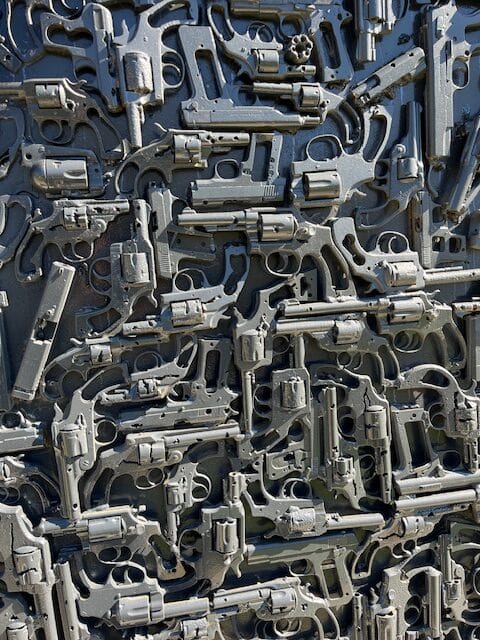
Once Esther Augsburger took her granddaughter to see the sculpture in Judiciary Square. She recalled later in a 2019 interview: “I saw this young chap with his head in his hands.” Augsburger asked him what he was thinking and the boy answered, “I come here every day after school because it helps me.” She said she didn’t ask the boy any details about his story but she wondered if the boy may have been affected by gun violence.
Esther and her husband, Myron Augsburger, a Mennonite pastor who was previously a president of Eastern Mennonite University, lived in D.C. in the 1990s and Esther Augsburger taught art classes to some youth who shared with her stories about being impacted by guns, which touched her deeply. The couple now lives in Harrisonburg.
In 2008 Guns Into Plowshares was removed from Judiciary Square. The artists didn’t even know where it was for a while. “It had been taken down and stowed at a facility on the outskirts of D.C. without permission,” said Barbara Gautcher, a resident of Harrisonburg and one of several board members of InterChurch, Inc., an organization that manages the sculpture. Then, according to a 2011 article in The Washington Post, written by John Kelly, the sculpture stood “forlornly” in a weedy lot. Gautcher said the sculpture was exposed to the weather and damaged.
Guns Into Plowshares was moved to Harrisonburg and the artists refurbished it. It was installed just south of the library on the EMU campus in 2017, and it was dedicated to Michael Augsburger, who had passed away earlier that year, according to EMU news. The plaque for the Harrisonburg sculpture installation said it was “a gift to Washington, D.C. as a symbol of hope.”
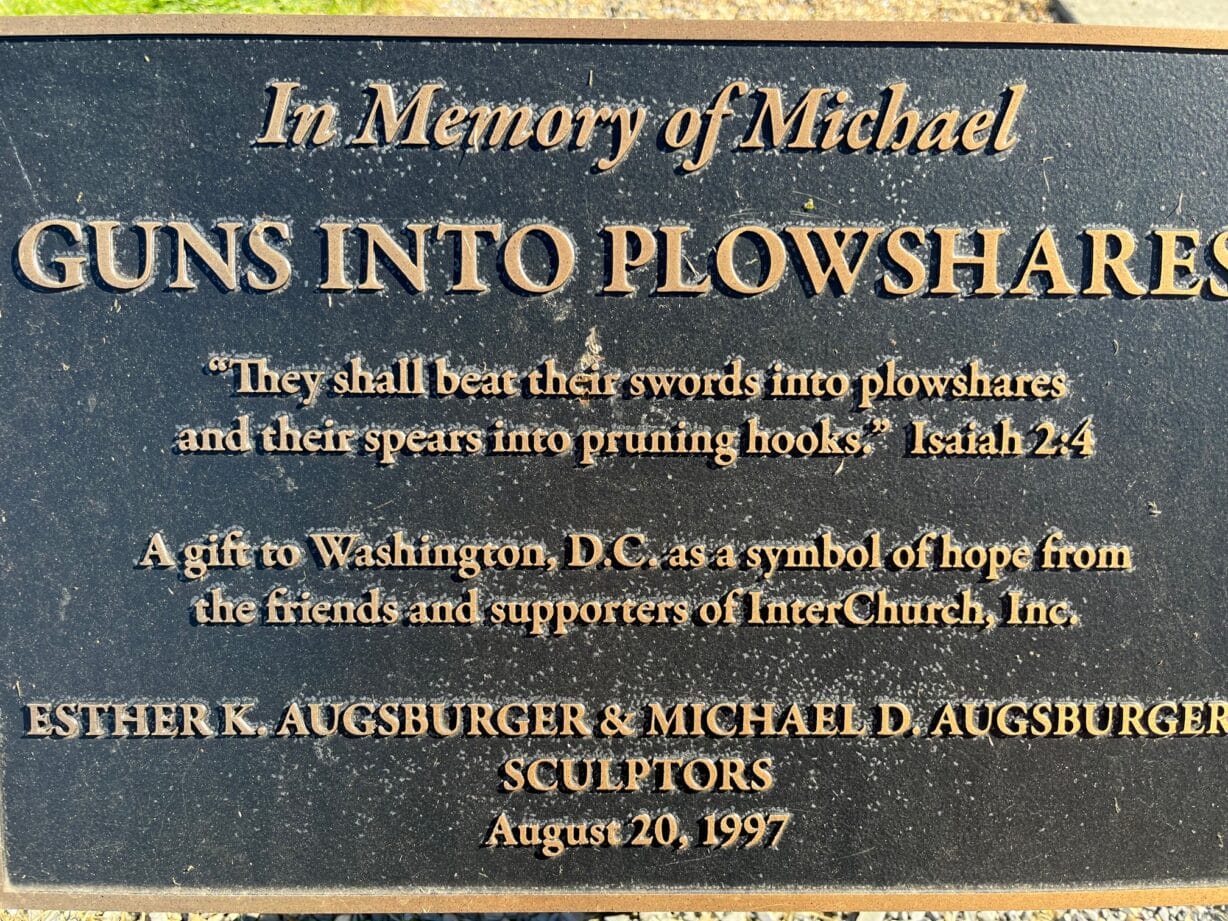
When I moved from the D.C. area to Harrisonburg in 2018, I became attentive to Guns Into Plowshares. I felt a kinship with the sculpture because we were both transplants from the D.C. area. I live about a mile from EMU and I often passed by the sculpture on walks. Sometimes I observed families with young children lingering by the sculpture or people posing for photos in front of it. Occasionally I paused to study some of those disabled guns that had once had human owners.
As a college writing instructor at EMU, I invited my students to engage with the sculpture. On September 9, 2019, Esther Augsburger gathered with some of my students and me around the sculpture. She told us stories and we interviewed her. “It’s handguns that kill people,” she said, and she explained that the sculpture was made of handguns that had been collected from owners by the D.C. police (through a buyback program, according to EMU news). She said the artwork also has a few automatic weapons. Augsburger explained that when her artist son, Michael, had learned about the guns that had been collected and that they would be melted down into fence posts, he had proposed the idea to use the disarmed guns to create a sculpture of a plowshare as a message of peace.
Esther and Michael created the sculpture in Harrisonburg, and when the Harrisonburg police chief saw it, Esther recalled, he said, “We want ten Harrisonburg guns on this sculpture.”
My students at EMU have been thoughtful in writing about the sculpture for a “responding to art” assignment. A few of them gave permission to share what they had written.
“Sadly this art is relevant today,” wrote Jordyn Thompson, now a junior preparing to be a secondary history teacher. She wrote that the sculpture draws attention to “the use of guns and gun violence, which is a pandemic in today’s society.”
“They shall beat their swords into plowshares and their spears into pruning hooks,” wrote Maya Tutton, quoting the Isaiah scripture that had inspired Guns Into Plowshares. She reflected that the scripture pointed out “what needs to happen in times of peace.” After all, she explained, “Farming does become more important than weapons if there are no threats.” At the same time, Tutton wrote that weapons are needed in times of war, noting that scripture from Joel 3:10 has the opposite message of the Isaiah passage. The verse from Joel says: “Beat your plowshares into swords, and your pruning hooks into spears.” Tutton is now a junior biology major.
After studying the sculpture, Nico MacGregor turned in the most detailed and interesting piece of writing that I had received from him up to that point. In his essay, he acknowledged that gun violence is a problem. He indicated that one way to address the problem is for everyone who uses a gun to be knowledgeable about gun safety and have a permit. He said he learned gun safety from his dad, and his dad didn’t permit him to use guns until he had understood it. MacGregor proceeded to identify some of the kinds of guns pressed into the sculpture. He identified Glocks and Uzis. He observed that some guns had a “spinning barrel that people see in the movies.” MacGregor reflected, “You don’t know the backstory of the guns because they all come together in a mold as a piece of art that is to be against gun violence, which to me is pretty interesting.” By engaging with the sculpture, MacGregor, who is now a junior liberal arts major, became engaged in writing.
Esther Augsburger told my students in 2019 that “we created the sculpture for Washington.” She declared that it would be moved back there. I thought at the time this was a pipe dream because I know that city bureaucracies are difficult to navigate.
But yesterday, on October 21, a crane removed the sculpture, and it was loaded on a flatbed track to be returned to D.C.
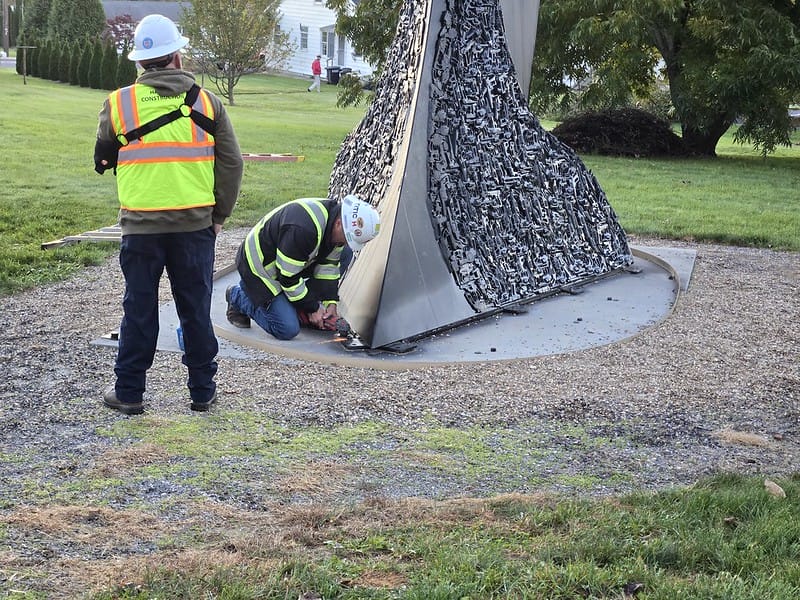
Guns Into Plowshares will be installed on “a grassy knoll” in the Southeast quadrant of D.C. on the property of the Homeland Security and Emergency Management Agency, said Gautcher. I expect that someone will update the Wikipedia entry with the sculpture’s new location. The InterChurch board members have been working with the D.C. police department and mayor’s office to execute the move and installation.
J. Daryl Byler, who is serving as a liaison between InterChurch and the D.C. mayor’s office, said in an email that Guns Into Plowshares will likely be installed some time this week at the site at 2720 Martin Luther King Jr. Avenue, SE. He said he’s seen the location and it will be “an excellent home” for the sculpture. The site is a mile from the church where the gun buyback program that provided many of the handguns for the sculpture took place.
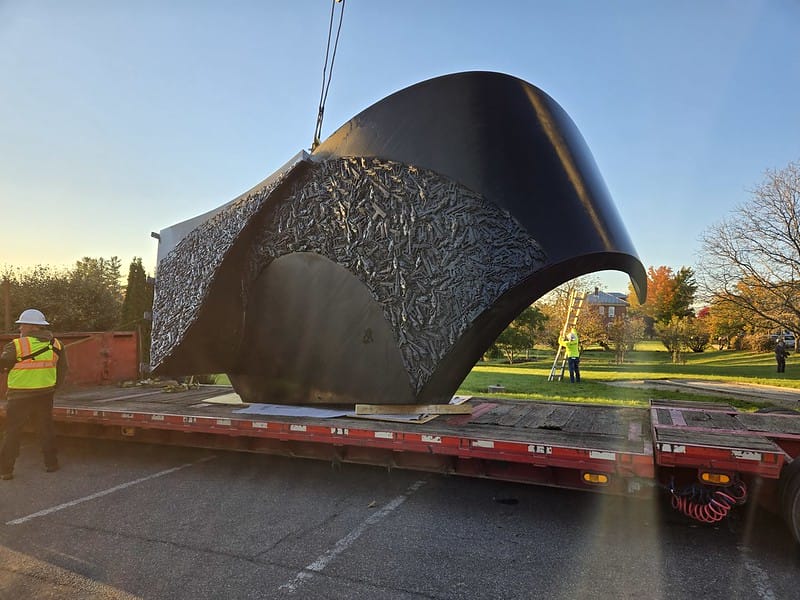

Byler reflected: “This has been a long journey. Esther has wanted the sculpture to be back in D.C. for a long time. The original understanding was that it was on loan to EMU for three years, which turned into seven while the D.C. government figured out where to locate the sculpture.”
In a statement sent to the EMU community by the Augsburger family on October 18, Esther and Myron Augsburger’s son, John, wrote: “In a culture devastated by gun violence, the artists, like the biblical prophets, dared to imagine a day when humans would find the strength and courage to feed others by tilling fields and harvesting crops, rather than destroying them with guns and weapons of war.”

My students and other Harrisonburg residents found meaning in the sculpture. Along with the managers of the sculpture, I trust the intention of the artists that Guns Into Plowshares was made for D.C. and belongs there. The Augsburger family plans to give a small replica–a Beta model–of Guns Into Plowshares to the EMU historical library, according to John Augsburger.
We in the Harrisonburg community are going to miss the actual full-scale sculpture.
Mary Ann Zehr is a rhetoric and composition instructor at Eastern Mennonite University. She is a co-author of the memoir, Doors Cracked Open: Teaching in a Chinese Closed City, published in 2024 by Resource Publications, an imprint of Wipf and Stock.
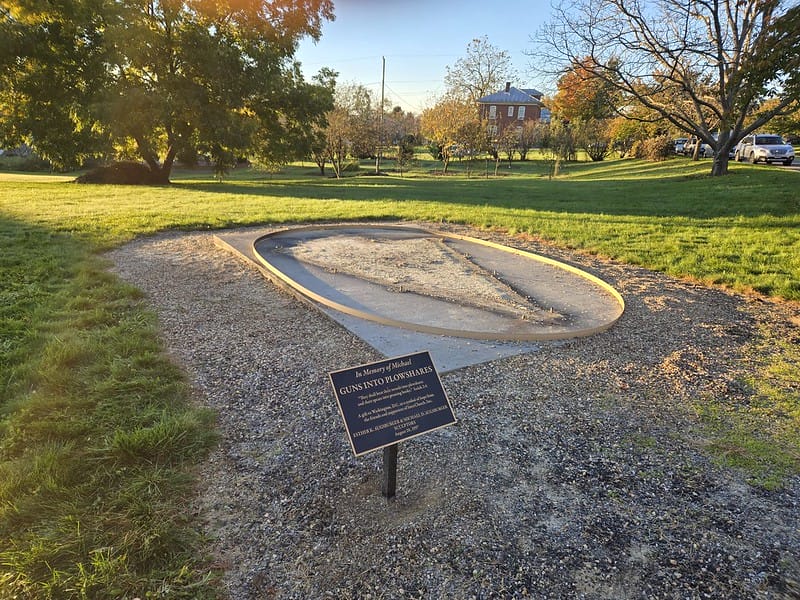
Editor’s Note – This post was edited on 10/28/24 to add a photo of the sculpture at its new location in Washington, D.C.
Thanks for reading The Citizen, which won the Virginia Press Association’s 2022 News Sweepstakes award as the top online news site in Virginia. We’re independent. We’re local. We pay our contributors, and the money you give goes directly to the reporting. No overhead. No printing costs. Just facts, stories and context. We value your support.












